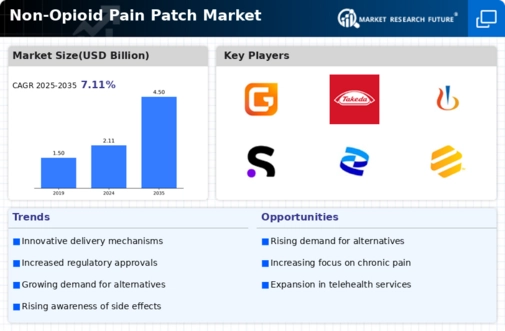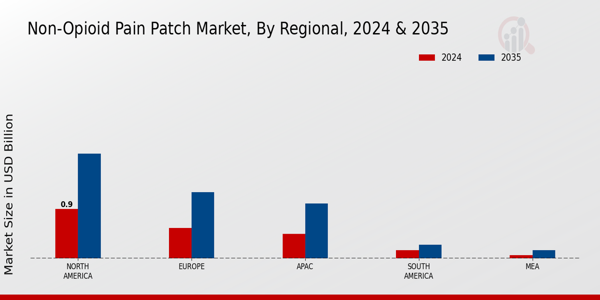Market Growth Projections
The Global Non-Opioid Pain Patch Market Industry is poised for substantial growth, with projections indicating a market value of 2.11 USD Billion in 2024 and an anticipated increase to 4.5 USD Billion by 2035. This growth trajectory suggests a compound annual growth rate (CAGR) of 7.13% from 2025 to 2035, reflecting the increasing adoption of non-opioid pain management solutions. The market dynamics are influenced by various factors, including technological advancements, regulatory support, and the rising prevalence of chronic pain conditions, all contributing to a robust and evolving landscape for non-opioid pain patches.
Rising Demand for Non-Opioid Alternatives
The Global Non-Opioid Pain Patch Market Industry experiences a surge in demand as healthcare providers and patients seek alternatives to opioid medications. This shift is largely driven by the increasing awareness of the risks associated with opioid use, including addiction and overdose. Non-opioid pain patches offer targeted relief with fewer side effects, appealing to a growing segment of the population concerned about opioid dependency. As a result, the market is projected to reach 2.11 USD Billion in 2024, reflecting a significant shift in pain management strategies across various demographics.
Regulatory Support for Non-Opioid Therapies
Regulatory bodies worldwide are increasingly supportive of non-opioid therapies, recognizing the need for safer pain management options. Initiatives aimed at reducing opioid prescriptions have led to a favorable environment for the Global Non-Opioid Pain Patch Market Industry. Governments are encouraging research and development of non-opioid alternatives, which may include financial incentives and streamlined approval processes. This regulatory landscape not only fosters innovation but also enhances market access for non-opioid pain patches, potentially leading to a compound annual growth rate (CAGR) of 7.13% from 2025 to 2035.
Technological Advancements in Pain Management
Innovations in transdermal drug delivery systems are propelling the Global Non-Opioid Pain Patch Market Industry forward. These advancements enhance the efficacy and safety of pain patches, allowing for controlled release of analgesics directly through the skin. For instance, the integration of microneedle technology has shown promise in improving drug absorption and minimizing side effects. Such technological progress not only boosts patient compliance but also expands the potential applications of non-opioid patches in chronic pain management. This trend is expected to contribute to the market's growth, with projections indicating a rise to 4.5 USD Billion by 2035.
Increasing Prevalence of Chronic Pain Conditions
The Global Non-Opioid Pain Patch Market Industry is significantly influenced by the rising prevalence of chronic pain conditions, such as arthritis, fibromyalgia, and neuropathic pain. As the global population ages, the incidence of these conditions is expected to increase, leading to a higher demand for effective pain management solutions. Non-opioid pain patches provide a viable option for patients seeking relief without the risks associated with traditional opioid therapies. This growing patient population is likely to drive market expansion, as healthcare systems adapt to meet the needs of those suffering from chronic pain.
Growing Awareness and Education on Pain Management
Public awareness and education regarding pain management options are on the rise, positively impacting the Global Non-Opioid Pain Patch Market Industry. Campaigns aimed at informing patients about the risks of opioids and the benefits of non-opioid alternatives are gaining traction. Healthcare professionals are also increasingly advocating for non-opioid therapies, leading to a shift in prescribing practices. As patients become more informed, they are more likely to seek out non-opioid pain patches as a first-line treatment option, thereby driving market growth and expanding the reach of these innovative pain management solutions.























